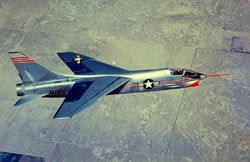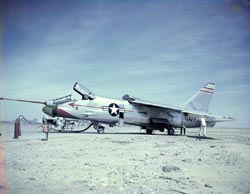|
 With the advent of supersonic flight, military aircraft were in the forefront of the effort to expand the envelope of knowledge in this new technology. The U.S. Air Force was fast developing the “century series” of fighter aircraft when, in September 1952, the U.S. Navy’s Bureau of Aeronautics issued a Request for Proposal for a carrier based day fighter capable of supersonic speed in level flight, with a “rugged construction” to withstand an arrested landing aboard the carrier at approximately 100 knots, folding outer wing panels to facilitate handling in the restricted spaces aboard ship, simplicity of maintenance, and fabricated of materials which can withstand the unfriendly atmosphere of open seas operations. Eight airframe manufacturers responded to this RFP, and the competition was quickly narrowed to consideration of the Grumman F11F and the Chance Vought XF8U-1. In May 1953 the Navy announced that the Vought design was the winner, and the real work of turning this design into hardware began. With the advent of supersonic flight, military aircraft were in the forefront of the effort to expand the envelope of knowledge in this new technology. The U.S. Air Force was fast developing the “century series” of fighter aircraft when, in September 1952, the U.S. Navy’s Bureau of Aeronautics issued a Request for Proposal for a carrier based day fighter capable of supersonic speed in level flight, with a “rugged construction” to withstand an arrested landing aboard the carrier at approximately 100 knots, folding outer wing panels to facilitate handling in the restricted spaces aboard ship, simplicity of maintenance, and fabricated of materials which can withstand the unfriendly atmosphere of open seas operations. Eight airframe manufacturers responded to this RFP, and the competition was quickly narrowed to consideration of the Grumman F11F and the Chance Vought XF8U-1. In May 1953 the Navy announced that the Vought design was the winner, and the real work of turning this design into hardware began.
 On 29 June 1953, the company received an order to build two prototype aircraft, designated as XF8U-1, and by February 1955, the first of these was ready to transport aboard an Air Force C-124 Globemaster to the U.S.A.F. Flight Test Center at Edwards Air Force Base in California. There, on the morning of 25 March 1955, only 21 months after design work had begun, the aircraft (Bu.No. 138899) lifted off the dry lake bed on its first flight with Vought chief test pilot John Konrad at the controls. The 51-minute flight entered the U.S.Navy into the era of supersonic operations by becoming the first aircraft ever to achieve supersonic flight on its first flight - the first of many such record setting achievements during the long service life of the Crusader, as the F8U series had been named. On 29 June 1953, the company received an order to build two prototype aircraft, designated as XF8U-1, and by February 1955, the first of these was ready to transport aboard an Air Force C-124 Globemaster to the U.S.A.F. Flight Test Center at Edwards Air Force Base in California. There, on the morning of 25 March 1955, only 21 months after design work had begun, the aircraft (Bu.No. 138899) lifted off the dry lake bed on its first flight with Vought chief test pilot John Konrad at the controls. The 51-minute flight entered the U.S.Navy into the era of supersonic operations by becoming the first aircraft ever to achieve supersonic flight on its first flight - the first of many such record setting achievements during the long service life of the Crusader, as the F8U series had been named.
The XF8U-1 design effort was not without its tense moments, with the most significant program glitch coming at the mid-point of design in 1954.
Connie Lau, Chief Aerodynamicist for the F-8U program came from the Cornell High Speed Wind Tunnel with the news that the airplane, as configured showed too much drag and would not meet the maximum speed guaranteed to the Navy. This was a bombshell which stopped the program in its tracks. The data was reviewed and confirmed. The John Whitcomb “Area Rule”, which consisted of a specific distribution of cross sectional area to reduce drag, was applied to the fuselage contours. This necessitated a complete redesign of the fuselage structure and the accompanying mechanisms and equipment installed therein.
Most any other Aerospace firm would have asked the customer for a schedule extension but that was not Vought’s way of doing business. Instead, Engineering was put on a 7 day, 80 hour work week to make the changes with a corresponding effort by the Manufacturing department. First flight date was met and the airplane met its maximum speed guarantees with a bit to spare.
The second XF8U-1, Bu.No. 138900, soon joined the flight test program at Edwards Air Force Flight Test Center in California, and together these two aircraft successfully completed the test program in superb fashion. On 25 October 1960, after 67 months of operations and 508 flights, XF8U-1 Number 1 was transferred to the Smithsonian’s Air and Space Museum where the aircraft was placed in storage at the Silver Hill, Maryland for many years. XF8U-1 Number 2 was scrapped after 460 flights.
F8U:
XF8U-1 Innovative Systems
XF8U-1 In The Cockpit
A New Aircraft and a New Coporation
F8U-1 and F8U-1E production Aircraft Changes
Life Extension
Loss of F8U-3 and a New Challenge
Last flight of the F8 (1999)
|